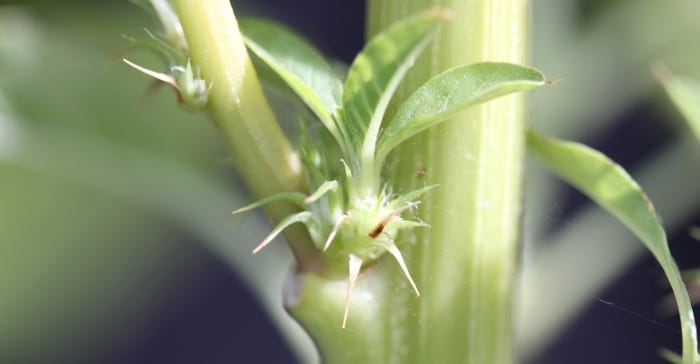
The top five weed control questions from the 2016 South Dakota State Fair and their answers from Paul O. Johnson, South Dakota University Extension weed science coordinator, were:
1. How do I know if I have Palmer amaranth or another amaranth such as waterhemp?
A few keys to look for on Palmer are that some of the petioles (the short stem from the main stem to the leaf) will be a lot longer than the leaf length; also, the area where the stem connects to the petioles will have spines on it. On Palmer the leaf is more cordate (heart-shaped) than on waterhemp, which is more elliptic (oblong). Lastly, the head will be long, and if female, will also be spiny. There is no one thing to look for that is a sure sign in all cases the plant is Palmer. It seems like we are more likely to find it in areas that have stress periods. So far, we have found it mainly in the central part of the state. Usually, we will find it in sunflower or soybean fields.

ID CLUES: One way to identify Palmer amaranth is to check the petioles (the short stem from the main stem to leaf). Palmer amaranth petioles are longer than the length of the leaves. (Photo: SDSU)

2. Which South Dakota noxious weed is the hardest to control?
Leafy spurge I would consider the toughest to eradicate. However, now with spurge beetles we can keep it from spreading and reduce the area and impact. They still will not control spurge in shady areas, areas that flood and ground with gravel or coarse soil.
3. How do I kill purslane in the field and garden?
Late in the season there are no real effective chemical methods to control purslane outside of pulling it and removing it from the affected area. If you just pull the plant and leave it, the plant will develop new roots off of areas where the plant branches, and it will keep growing. You can pull purslane from the garden and use it in salads or soup!
4. How do I kill ground ivy in the farm lawn?
Autumn is an excellent time to control ground ivy. Best results are obtained when a full rate of a mix with 2,4-D, dicamba and MCPP is used. Then, as soon as the label allows, do a repeat application, ideally in about two weeks.
5. How do I kill the crab grass or sandburs in the lawn?
In the spring, about when the lilacs are blooming, put on a preemergence product. In the case of sandbur, wait until about June 1. This will give you seasonlong control on an average year, but in a wet year you will need to look at following up with a postemergence product when seedlings are small (three- to four-leaf stage).

ANOTHER CLUE: On a Palmer amaranth plant, there will be spines where the stem connects to the petioles. (Photo: SDSU)

About the Author(s)
You May Also Like






